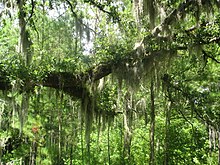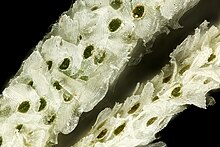bio.wikisort.org - Plant
Spanish moss (Tillandsia usneoides) is an epiphytic flowering plant that often grows upon large trees in tropical and subtropical climates. It is native to much of Mexico, Bermuda, the Bahamas, Central America, South America, the Southern United States, and West Indies. It has been naturalized in Queensland (Australia). It is known as "grandpa's beard" in French Polynesia.[3]
| Spanish moss | |
|---|---|
 | |
Conservation status | |
| Scientific classification | |
| Kingdom: | Plantae |
| Clade: | Tracheophytes |
| Clade: | Angiosperms |
| Clade: | Monocots |
| Clade: | Commelinids |
| Order: | Poales |
| Family: | Bromeliaceae |
| Genus: | Tillandsia |
| Subgenus: | Tillandsia subg. Diaphoranthema |
| Species: | T. usneoides |
| Binomial name | |
| Tillandsia usneoides | |
| Synonyms[3] | |
| |
Most known in the United States, it commonly is found on the southern live oak (Quercus virginiana) and bald cypress (Taxodium distichum) in the lowlands, swamps, and marshes of the mid-Atlantic and southeastern states, from the coast of southeastern Virginia to Florida and west to southern Arkansas and Texas.[4][5]
The specific name of the plant, usneoides, means "resembling Usnea", a lichen.[6] While it superficially resembles its namesake, it is neither a lichen such as Usnea nor a moss, and it is not native to Spain.
It is a flowering plant (angiosperm) in the family Bromeliaceae (the bromeliads) that grows hanging from tree branches in full sun through partial shade. Formerly, it was placed in the genera Anoplophytum, Caraguata, and Renealmia.[7] The northern limit of its natural range is Northampton County, Virginia,[8] with colonial-era reports of it in southern Maryland[9][page needed][10][11][12] where no populations are now known to exist.[12] Its primary range is in the southeastern United States (including Puerto Rico and the U.S. Virgin Islands) through Argentina, where the climate is warm enough and a relatively high average humidity occurs.
It has been introduced to locations around the world with similar conditions, including Hawaii and Australia.
Description

Spanish moss consists of one or more slender stems, bearing alternate thin, curved or curly, and heavily scaled leaves 2–6 cm (0.8–2.4 inches) long and 1 mm (0.04 inches) broad, that grow vegetatively in a chain-like fashion (pendant), forming hanging structures of up to 6 m (20 feet).[13]
The plant has no roots,[14][13] and its brown, green, yellow, or grey flowers are tiny and inconspicuous. It propagates both by seed and vegetatively by fragments that are carried on the wind and stick to tree limbs or that are carried to other locations by birds as nesting material.
Ecology

Spanish moss is not parasitic, it is an epiphyte that absorbs nutrients and water through its own leaves from the air and rain falling upon it. While its presence rarely kills the trees on which it grows, it occasionally becomes so thick that, by shading the leaves of the tree, it slows the growth rate of the tree.[13] It can use the water-conserving strategy of crassulacean acid metabolism for photosynthesis.[15][16]
In the southern U.S., the plant seems to show preferences for southern live oak (Quercus virginiana) and bald cypress (Taxodium distichum) because of their high rates of foliar mineral leaching (calcium, magnesium, potassium, and phosphorus) that provides an abundant supply of nutrients to the epiphytic plant.[17] It also can colonize other tree species such as sweetgum (Liquidambar styraciflua), crepe-myrtles (Lagerstroemia spp.), other oaks, and even pines.
Spanish moss shelters a number of creatures, including rat snakes and three species of bats. One species of jumping spider, Pelegrina tillandsiae, has been found only on Spanish moss.[18] Although widely presumed to infest Spanish moss, in one study of the ecology of the plant, chiggers were not present among thousands of other arthropods identified on the plant.[19]
Culture and folklore

Spanish moss often is associated with Southern Gothic imagery and Deep South culture, due to its propensity for growing in subtropical humid southern locales such as Alabama, Florida, Georgia, Louisiana, Mississippi, North Carolina, South Carolina, east and south Texas, and extreme southern Virginia.
One anecdote about the origin of Spanish moss is called "The Meanest Man Who Ever Lived", in which the man's white hair grew very long and got caught on trees.[20]
Spanish moss was introduced to Hawaii in the nineteenth century. It became a popular ornamental and lei plant.[21] In Hawaii, it was named "ʻumiʻumi-o-Dole" after the beard of Sanford B. Dole, the first president of the Provisional Government of Hawaii. It also is known as hinahina, ("silvery") borrowing the name of the native heliotrope used in lei until shoreline development made access difficult. It has become a substitute for the native hinahina in lei used for pageantry. In the early 21st Century the plant was heavily marketed as "Pele's hair"/"lauoho-o-Pele," which actually refers to a type of filamentous volcanic glass.)
Human uses



Spanish moss has been used for various purposes, including building insulation, mulch, packing material, mattress stuffing, and fiber. In the early 1900s it was used commercially in the padding of car seats.[22] More than 10,000 tons of processed Spanish-moss was produced in 1939.[23] Today, it is collected in smaller quantities for use in arts and crafts, as bedding for flower gardens, and as an ingredient in bousillage, a traditional wall covering material. In some parts of Latin America and Louisiana, it is used in Nativity scenes.
In the desert regions of southwestern United States, sometimes dried Spanish moss is used in the manufacture of evaporative coolers, colloquially known as "swamp coolers" (and in some areas as "desert coolers"), which are used to cool homes and offices much less expensively than air conditioners. The cooling technology uses a pump that squirts water onto a pad made of Spanish moss plants; a fan then pulls air through the pad, and into the building. Evaporation of the water on the pads serves to reduce air temperature, cooling the building.[24]
Varieties and cultivars
- Tillandsia 'Maurice's Robusta'[25]
- Tillandsia 'Munro's Filiformis' : a natural variety with very fine, green leaves that is native to Paraguay and that also is known in the United States by the trade designations Tillandsia usneoides El Finito and Silver Ghost, it conforms to the description of the now-defunct variety Tillandsia usneoides var. filiformis (André) Mez[26]
- Tillandsia 'Odin's Genuina' : a natural variety with brown rather than green or yellow flower petals that is native to Guatemala and Mexico[27]
- Tillandsia 'Spanish Gold'[28]
- Tillandsia 'Tight and Curly'[29]
Hybrids
- Tillandsia 'Nezley' (Tillandsia usneoides × mallemontii)[30]
- Tillandsia 'Kimberly' (Tillandsia usneoides × recurvata)[31]
- Tillandsia 'Old Man's Gold' (Tillandsia crocata × usneoides)[32]
See also
- Lace lichen, an organism of similar habit and appearance
References
- Treviño Zevallos, I. (2019). "Tillandsia usneoides". IUCN Red List of Threatened Species. 2019: e.T131368905A131369229. doi:10.2305/IUCN.UK.2019-3.RLTS.T131368905A131369229.en. Retrieved 16 October 2022.
- "Tillandsia usneoides". Germplasm Resources Information Network (GRIN). Agricultural Research Service (ARS), United States Department of Agriculture (USDA). Retrieved 2009-12-08.
- Kew World Checklist of Selected Plant Families, Tillandsia usneoides
- Luther, Harry E.; Brown, Gregory K. (2000). "Tillandsia usneoides". In Flora of North America Editorial Committee (ed.). Flora of North America North of Mexico (FNA). Vol. 22. New York and Oxford – via eFloras.org, Missouri Botanical Garden, St. Louis, MO & Harvard University Herbaria, Cambridge, MA.
- "Tillandsia usneoides". County-level distribution map from the North American Plant Atlas (NAPA). Biota of North America Program (BONAP). 2014.
- Damrosch, B.; Neal, B. (2003). Gardener's Latin: A Lexicon. Chapel Hill, N.C: Algonquin Books. p. 129. ISBN 978-1-56512-743-2. OCLC 856021571. Retrieved 20 April 2019.
- "Tillandsia". Germplasm Resources Information Network (GRIN). Agricultural Research Service (ARS), United States Department of Agriculture (USDA).
- Times-Dispatch, REX SPRINGSTON Richmond. "Virginia scientists search for northernmost realm of Spanish moss". Richmond Times-Dispatch. Retrieved 2017-10-26.
- Ray, John (1688). "Historiæ Plantarum Tomus Secondus: cum Duplici Indice; Generali Altero Nominum & Synonymorum præcipuorum; Altero Affectuum & Remediorum: Accessit Nomenclator Botanicus Anglo-Latinus". Translated by Raii, Joannis. London.
- "Plants profile for Tillandsia usneoides". USDA.
- "Rare, Threatened, and Endangered Plants of Maryland" (PDF).
- Brown, M.L., and R.G. Brown (1984). Herbaceous plants of Maryland. Baltimore: Port City Press, Inc.
{{cite book}}: CS1 maint: uses authors parameter (link) - "Tillandsia usneoides". Floridata Plant Encyclopedia.
- "Sustainability-Spanish Moss". Institute of Food and Agricultural Sciences (IFAS), UF. 2020-05-06. Retrieved 2021-10-28.
- Kluge, M; Lange, O L; Eichmann, M V; Schmid, R (1973). "CAM in Tillandsia usneoides: Studies on the pathway of carbon and the dependency of CO2-exchange on light intensity, temperature and water content of the plant (in German)". Planta. 112 (4): 357–72. doi:10.1007/BF00390308. PMID 24468815.
- Haslam, Richard; Borland, Anne; Maxwell, Kate; Griffiths, Howard (2003). "Physiological responses of the CAM epiphyte Tillandsia usneoides L. (Bromeliaceae) to variations in light and water supply". Journal of Plant Physiology. 160 (6): 627–34. doi:10.1078/0176-1617-00970. PMID 12872484.
- Schlesinger, William H.; Marks, P. L. (1977). "Mineral Cycling and the Niche of Spanish Moss, Tillandsia usneoides L.". American Journal of Botany. 64 (10): 1254–1262. doi:10.2307/2442489. JSTOR 2442489.
- Wildlife, State of Texas, Parks and. "Flora Fact:| Spanish Moss Serves as Nature's Draperies". www.tpwmagazine.com. Retrieved 2017-10-26.
- Whitaker Jr., J; Ruckdeschel, C. (2010). "Spanish Moss, the Unfinished Chigger Story". Southeastern Naturalist. 9 (1): 85–94. doi:10.1656/058.009.0107. S2CID 86228838.
- Friedman, Amy; Johnson, Meredith (May 28, 2017). "The Meanest Man Who Ever Lived (An American Folktale)". Uexpress. Retrieved May 31, 2017.
- "Nā Lei o Hawai'i – Types of Lei". Archived from the original on 2013-01-03.
- "Hair From Trees....Spanish-moss is new upholstering material". Popular Science. June 1937.
- Adams, Dennis. Spanish Moss: Its Nature, History and Uses. Beaufort County Library, SC.
- Gutenberg, Arthur William (1955). The Economics of the Evaporative Cooler Industry in the Southwestern United States. Stanford University Graduate School of Business. p. 167.
- Bromeliad Cultivar Registry: Tillandsia 'Maurice's Robusta'
- Bromeliad Cultivar Registry: Tillandsia 'Munro's Filiformis'
- Bromeliad Cultivar Registry: Tillandsia 'Odin's Genuina'
- Bromeliad Cultivar Registry: Tillandsia 'Spanish Gold'
- Bromeliad Cultivar Registry: Tillandsia 'Tight and Curly'
- Bromeliad Cultivar Registry: Tillandsia 'Nezley'
- Bromeliad Cultivar Registry: Tillandsia 'Kimberly'
- Bromeliad Cultivar Registry: Tillandsia 'Old Man's Gold'
- Mabberley, D.J. 1987. The Plant Book. A Portable Dictionary of the Higher Plants. Cambridge University Press, Cambridge. ISBN 0-521-34060-8.
External links
- Spanish Moss: Its History, Nature and Uses — Beaufort County Library
- Florida Forest Plants
- Florida Spanish Moss: Theory — Does Spanish Moss kill trees?
- What’s in a name? Itla-okla, ʻUmiʻumi-o-Dole, Spanish Moss
- Flowers Used for Lei
На других языках
- [en] Spanish moss
[es] Tillandsia usneoides
El musgo español, barba del viejo, heno, paste, salvajina, salvajino, cuarque, guajaca (Cuba), barbas de úcar (Puerto Rico), pelo de bruja, melena (Colombia),[2] agavepalo, paxtle, paistle, heno (México),[3] barbasco, huayhuaco, sagopra, sahopra o salvagina (Perú), barba de palo (Venezuela), barbón o heno (Chile),[4] (Tillandsia usneoides) es muy parecido al nombre que evoca la especie Usnea, un liquen. Aunque Tillandsia no guarda relación biológica con Usnea; sino que es una fanerógama de la familia de las bromeliáceas, que vive en ramas de árboles a pleno sol o a media sombra. Se puede encontrar desde el sudeste de EE. UU. a Argentina y Chile, creciendo en clima tibio, y preferentemente con alta humedad.[fr] Tillandsia usneoides
Mousse espagnole[ru] Тилландсия уснеевидная
Тилла́ндсия уснееви́дная[1], или Испа́нский мох, или Луизиа́нский мох[1], или Испанская борода́ (лат. Tillandsia usneoides) — растение семейства Бромелиевые.Другой контент может иметь иную лицензию. Перед использованием материалов сайта WikiSort.org внимательно изучите правила лицензирования конкретных элементов наполнения сайта.
WikiSort.org - проект по пересортировке и дополнению контента Википедии
